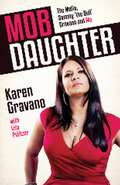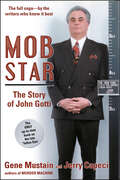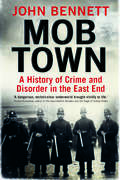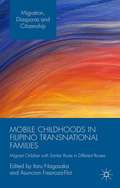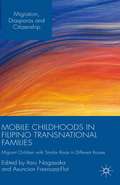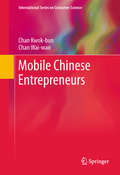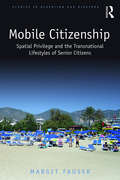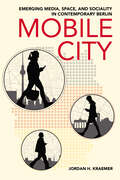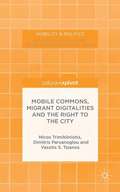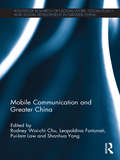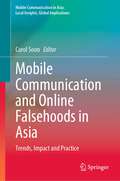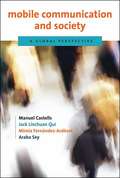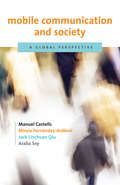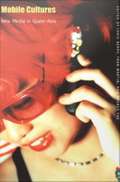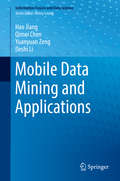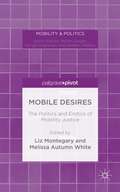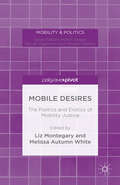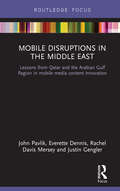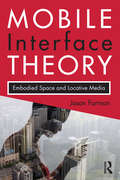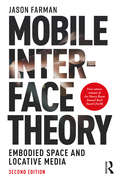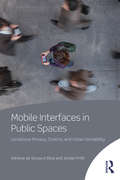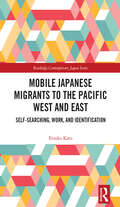- Table View
- List View
Mob Daughter: The Mafia, Sammy 'The Bull' Gravano and Me!
by Karen GravanoKaren Gravano is the daughter of Sammy 'the Bull' Gravano, one of the Mafia's most feared hitmen who confessed to nineteen murders. When her father turned his back on the Mafia and cooperated with the Feds, her family were left broken and living in fear of retaliation. This is the compelling true account of her life as a Mob daughter.
Mob Girl: A Woman's Life In the Underworld
by Teresa CarpenterThis biography of Arlyne Brickman and her life involved with organized crime. The biography depicts her in every role: girlfriend, operative, and informant.
Mob Killer:
by Destefano Anthony M.A Crazed Killer He dissolved the bodies of some of his victims in acid and poured them down the sewer. He hung grisly souvenirs on nails in his junkyard. La Costra Nostra Charles Carneglia was a stone-cold killer who fell in with the bloodthirsty John Gotti crew. As the infamous crime family rose to power with their murderous trail of sex, jealousy, greed, and revenge, Carneglia rose with them. Mafia, Madness And Murder This is the horrifying story of a misfit who fit perfectly into the New York mafia. In a harrowing journey inside a ruthless criminal underworld, Pulitzer Prize-winning reporter Anthony M. DeStefano chronicles one man's life in a world of depraved acts of violence and the horrors that went with being a member of the Gambino family. "Thrilling American crime writing. " -Jimmy Breslin on King of the Godfathers Includes 16 Pages of Shocking Photos
Mob Star: The Story of John Gotti
by Gene Mustain Jerry CapeciHe was a little-known wiseguy out of Howard Beach, Queens, who blasted his way into the public eye with the assassination of Gambino Family boss Paul Castellano in December 1985, a rubout that&’s the stuff of Mafia legend. Ruthless, cunning, and tougher than the streets that produced him, John Gotti seized control of the nation&’s most powerful crime family, beat the law on rap after rap, and became an American legend. First published in 1988 and fully revised and updated for this edition, Mob Star traced John Gotti&’s spectacular rise and eventual downfall after the betrayal of his closest ally, Salvatore &“Sammy Bull&” Gravano. At his death, ten years after he was jailed for life and four years after he began battling cancer, John Gotti was still the biggest name in today&’s Mafia.
Mob Town: A History of Crime and Disorder in the East End
by John BennettA captivating history of a notorious neighborhood and the first book to reveal why London’s East End became synonymous with lawlessness and crime Even before Jack the Ripper haunted its streets for prey, London’s East End had earned a reputation for immorality, filth, and vice. John Bennett, a writer and tour guide who has walked and researched the area for more than thirty years, delves into four centuries of history to chronicle the crimes, their perpetrators, and the circumstances that made the East End an ideal breeding ground for illegal activity. In the eighteenth and nineteenth centuries, Britain’s industrial boom drew thousands of workers to the area, leading to overcrowding and squalor. But crime in the area flourished long past the Victorian period. Drawing on original archival history and featuring a fascinating cast of characters including the infamous Ripper, highwayman Dick Turpin, the Kray brothers, and a host of ordinary evildoers, this gripping and deliciously unsavory volume will fascinate Londonphiles and true crime lovers alike.
Mobile Childhoods in Filipino Transnational Families: Migrant Children with Similar Roots in Different Routes (Migration, Diasporas and Citizenship)
by Asuncion Fresnoza-Flot Itaru NagasakaMobile Childhoods in Filipino Transnational Families focuses on the lived experiences of '1.5-generation' migrants with similar 'roots' (the Philippines), traversing different 'routes' (receiving countries). By shedding light on the diversified paths of their migratory lives, it revisits the relationships between mobility, sociality and identity.
Mobile Childhoods in Filipino Transnational Families: Migrant Children with Similar Roots in Different Routes (Migration, Diasporas and Citizenship)
by Asuncion Fresnoza-Flot Itaru NagasakaMobile Childhoods in Filipino Transnational Families focuses on the lived experiences of '1.5-generation' migrants with similar 'roots' (the Philippines), traversing different 'routes' (receiving countries). By shedding light on the diversified paths of their migratory lives, it revisits the relationships between mobility, sociality and identity.
Mobile Chinese Entrepreneurs
by Chan Kwok-Bun Chan Wai-WanMobile Chinese Entrepreneurs draws extensively on the narratives of sixteen small-to-medium business owners, born on the mainland, who have immigrated to Hong Kong and returned to their ancestral hometowns in China to establish their enterprises. For these executives, business and social life alike are marked by constant interplay of identities, such as individual identity/group membership and ancestral/immigrant identity. Yet as often as this juggling of multiple "selves" can be beneficial in the economic sphere, it can also lead to feelings of rootlessness and alienation. Writing with rare sensitivity, the two authors synthesize insights from economic sociology, psychology, ethnic relations, emotions, and social networks, creating an exploration of social capital and social identity comparable to similar groups of businessmen and -women in other parts of the world.
Mobile Citizenship: Spatial Privilege and the Transnational Lifestyles of Senior Citizens (Studies in Migration and Diaspora)
by Margit FauserMobile Citizenship addresses the crucial question of how mobility reconfigures citizenship. Engaging with debates on transnationalism, citizenship, and lifestyle migration, the book draws on ethnographic research and interview material collected among retired lifestyle migrants moving south from Germany to Turkey to explore the practices and narratives of these privileged migrants. Revealing the ways in which these migrants relate to their old homes and to their new places, the author examines the social, political, and spatial dimensions of citizenship and belonging and argues that citizenship is key to understanding the privileges of transnational lifestyles. By taking up discussions emanating from studies on other privileged lifestyle migrations—around social welfare and well-being, social participation, and affective belonging, as well as class and racialized privileges—the book exposes particular comparative value and showcases similarities and differences across this emerging type of migration. Mobile Citizenship thus shows how citizenship allows for mobility, resources, and privilege yet is also replete with limitations and ambivalences. The book brings together perspectives on citizenship, space, and privilege and will appeal to social scientists with interests in lifestyle migration and citizenship and their interconnections with global and social inequalities.
Mobile City: Emerging Media, Space, and Sociality in Contemporary Berlin
by Jordan H. KraemerIn Mobile City, Jordan H. Kraemer charts the rise of social media and an emerging "knowledge" class in early-2000s Berlin. Many young Germans and EU-Ausländer (foreigners from other EU countries), attracted to Berlin's vibrant post-unification counterculture, moved to the city just as they began using social media like Facebook and Twitter. Social media and Berlin alike became hip sites for urban, middle-class aspirations, but, as Kraemer accounts, social media users became embroiled in contestations over class mobility and identity, as urban planners and developers remade Berlin into a neoliberal "creative city."The rise of this creative city involved scale-making projects that fused imaginaries of digital technologies with the expansive impulses of late capital: a vision of world peace and economic cooperation through global interconnection. But in Berlin, scalar transformations were lived out through ordinary practices that reconfigured daily sociality, mobility, and urban space. Mobile City explores how digital media practices forged emergent scales like the global and supranational yet were equally complicit in potential European disintegration and illiberalism.
Mobile Commons, Migrant Digitalities and the Right to the City
by Nicos Trimikliniotis Dimitris Parsanoglou Vassilis S. TsianosThis book examines the relationship between urban migrant movements, struggles and digitality which transforms public space and generates mobile commons. Empirically conducted during the time of crisis-and-austerity, the research draws on struggles in Athens, Nicosia and Istanbul, but also extends to the eastern Mediterranean borders. The authors explore heterogeneous digital forms in the context migration, border-crossing and transnational activism, displaying commonality patterns and inter-dependence. The interaction between actors generates powerful transformation effects at different levels: struggles for daily survival and more visible or subtle struggles for recognition, representation and/or settlement. Albeit legally inchoate, such vibrant struggles contribute to the establishment of informal socially embedded 'rights' and new 'acts of citizenship'. Mobile commons are socially practiced rights to be mobile which subvert technological and sovereign control to allow for the subject invisibility, multiplicity and freedom from surveillance.
Mobile Communication and Greater China (Routledge Research on Social Work, Social Policy and Social Development in Greater China)
by Pui-Lam Law Leopoldina Fortunati Rodney Wai-chi Chu Shanhua YangThis edited volume is the first book-length study focusing entirely on mobile phone use in China. Drawing on examples from a wide range of contemporary situations in China and beyond, the contributors argue that the mobile phone is in fact an important means by which one can understand a rapidly changing China, and the developing culture of mobile phone usage reflects both the cultural norms and struggle of the people. Through a theoretical comparison of usage in the West and in China, the editors assert the uniqueness of China’s experience, highlighting that Chinese society is being exposed simultaneously to a rapid process of industrialization and cyberization. The contributors maintain that such density of experience under a compressed period combined with a thick cultural heritage and a country still under a dictating rule provides a unique situation and offers deep insights into Chinese culture in general. This work will be of great interest to all students and scholars of Asian communication studies, ICT and Chinese culture and society.
Mobile Communication and Online Falsehoods in Asia: Trends, Impact and Practice (Mobile Communication in Asia: Local Insights, Global Implications)
by Carol SoonThis book focuses on developments and trends pertaining to online falsehoods and mobile instant messaging services (MIMS), the impact of online falsehoods transmitted via MIMS, and practice and intervention. As the reliance on mobile devices for news seeking and information sharing continues to grow, the spread of online falsehoods on MIMS is a problem that confounds academics, practitioners, and policymakers. Recent developments in countries such as Brazil and India demonstrate how MIMS facilitate the spread of online falsehoods. Given that a number of non-academic and non-governmental institutions in the region are doing important work in countering the influence of online falsehoods, this book also includes contributions by practitioners who design initiatives and programmes in this area. The book is a timely contribution in addressing the distinct issues of online falsehoods in a large, technophilic region such as Asia, grappling with problems of online falsehoods on so many fronts, including ideological extremism, political opportunism, cyberscams, political activism, digitalised learning, geopolitical tensions, and more. Relevant to researchers and policymakers, this book provides a timely and critical analysis of both research and practice conducted in the Asian context by scholars hailing from a range of disciplines such media studies, political communication, cultural studies, and cognitive science.
Mobile Communication and Society
by Manuel Castells Araba Sey Mireia Fernández-Ardèvol Jack Linchuan QiuWireless networks are the fastest growing communications technology in history. Are mobile phones expressions of identity, fashionable gadgets, tools for life--or all of the above? Mobile Communication and Society looks at how the possibility of multimodal communication from anywhere to anywhere at any time affects everyday life at home, at work, and at school, and raises broader concerns about politics and culture both global and local.Drawing on data gathered from around the world, the authors explore who has access to wireless technology, and why, and analyze the patterns of social differentiation seen in unequal access. They explore the social effects of wireless communication--what it means for family life, for example, when everyone is constantly in touch, or for the idea of an office when workers can work anywhere. Is the technological ability to multitask further compressing time in our already hurried existence?The authors consider the rise of a mobile youth culture based on peer-to-peer networks, with its own language of texting, and its own values. They examine the phenomenon of flash mobs, and the possible political implications. And they look at the relationship between communication and development and the possibility that developing countries could "leapfrog" directly to wireless and satellite technology. This sweeping book--moving easily in its analysis from the United States to China, from Europe to Latin America and Africa--answers the key questions about our transformation into a mobile network society.
Mobile Communication and Society: A Global Perspective (Information Revolution and Global Politics)
by Manuel Castells Araba Sey Jack Linchuan Qiu Mireia Fernandez-ArdevolHow wireless technology is redefining the relationship of communication, technology, and society around the world—in everyday work and life, in youth culture, in politics, and in the developing world. Wireless networks are the fastest growing communications technology in history. Are mobile phones expressions of identity, fashionable gadgets, tools for life—or all of the above? Mobile Communication and Society looks at how the possibility of multimodal communication from anywhere to anywhere at any time affects everyday life at home, at work, and at school, and raises broader concerns about politics and culture both global and local. Drawing on data gathered from around the world, the authors explore who has access to wireless technology, and why, and analyze the patterns of social differentiation seen in unequal access. They explore the social effects of wireless communication—what it means for family life, for example, when everyone is constantly in touch, or for the idea of an office when workers can work anywhere. Is the technological ability to multitask further compressing time in our already hurried existence?The authors consider the rise of a mobile youth culture based on peer-to-peer networks, with its own language of texting, and its own values. They examine the phenomenon of flash mobs, and the possible political implications. And they look at the relationship between communication and development and the possibility that developing countries could "leapfrog" directly to wireless and satellite technology. This sweeping book—moving easily in its analysis from the United States to China, from Europe to Latin America and Africa—answers the key questions about our transformation into a mobile network society.
Mobile Cultures: New Media in Queer Asia
by Chris Berry Audrey Yue Fran MartinMobile Cultures provides much-needed, empirically grounded studies of the connections between new media technologies, the globalization of sexual cultures, and the rise of queer Asia. The availability and use of new media--fax machines, mobile phones, the Internet, electronic message boards, pagers, and global television--have grown exponentially in Asia over the past decade. This explosion of information technology has sparked a revolution, transforming lives and lifestyles, enabling the creation of communities and the expression of sexual identities in a region notorious for the regulation of both information and sexual conduct. Whether looking at the hanging of toy cartoon characters like "Hello Kitty" from mobile phones to signify queer identity in Japan or at the development of queer identities in Indonesia or Singapore, the essays collected here emphasize the enormous variance in the appeal and uses of new media from one locale to another. Scholars, artists, and activists from a range of countries, the contributors chronicle the different ways new media galvanize Asian queer communities in Taiwan, South Korea, Japan, Indonesia, Thailand, Malaysia, India, and around the world. They consider phenomena such as the uses of the Internet among gay, lesbian, or queer individuals in Taiwan and South Korea; the international popularization of Japanese queer pop culture products such as Yaoi manga; and a Thai website's reading of a scientific tract on gay genetics in light of Buddhist beliefs. Essays also explore the politically subversive possibilities opened up by the proliferation of media technologies, examining, for instance, the use of Cyberjaya--Malaysia's government-backed online portal--to form online communities in the face of strict antigay laws. Contributors. Chris Berry, Tom Boellstorff, Larissa Hjorth, Katrien Jacobs, Olivia Khoo, Fran Martin, Mark McLelland, David Mullaly, Baden Offord, Sandip Roy, Veruska Sabucco, Audrey Yue
Mobile Data Mining and Applications (Information Fusion and Data Science)
by Hao Jiang Qimei Chen Yuanyuan Zeng Deshi LiThis book focuses on mobile data and its applications in the wireless networks of the future. Several topics form the basis of discussion, from a mobile data mining platform for collecting mobile data, to mobile data processing, and mobile feature discovery. Usage of mobile data mining is addressed in the context of three applications: wireless communication optimization, applications of mobile data mining on the cellular networks of the future, and how mobile data shapes future cities. In the discussion of wireless communication optimization, both licensed and unlicensed spectra are exploited. Advanced topics include mobile offloading, resource sharing, user association, network selection and network coexistence. Mathematical tools, such as traditional convexappl/non-convex, stochastic processing and game theory are used to find objective solutions. Discussion of the applications of mobile data mining to cellular networks of the future includes topics such as green communication networks, 5G networks, and studies of the problems of cell zooming, power control, sleep/wake, and energy saving. The discussion of mobile data mining in the context of smart cities of the future covers applications in urban planning and environmental monitoring: the technologies of deep learning, neural networks, complex networks, and network embedded data mining. Mobile Data Mining and Applications will be of interest to wireless operators, companies, governments as well as interested end users.
Mobile Desires: The Politics and Erotics of Mobility Justice (Mobility & Politics)
by Liz Montegary Melissa Autumn WhiteMobile Desires.
Mobile Desires: The Politics and Erotics of Mobility Justice (Mobility & Politics)
by Liz Montegary Melissa Autumn WhiteThis book combines mobilities research with feminist and queer studies offering new perspectives on mobility justice. It foregrounds academic, activist, and artistic work revealing state-sponsored strategies for managing the mobility of people as mechanisms for aligning erotic and political desires with capitalist and nationalist interests.
Mobile Disruptions in the Middle East: Lessons from Qatar and the Arabian Gulf Region in mobile media content innovation (Disruptions)
by Justin Gengler John V Pavlik Everette E Dennis Rachel Davis MerseyMobile Disruptions in the Middle East identifies trends in mobile media use in Qatar and the United Arab Emirates and, more broadly, explores their impact on the nature of digital journalism. Mobility has long been an important aspect of life in the Middle East; therefore a study of this region presents a unique opportunity to examine the role of mobile media and its future directions. Basing its analysis on original research, including multiyear surveys and case studies, the book reveals patterns of audience engagement with mobile media in the Gulf area, with particular emphasis on online journalism. The research also illustrates how and to what extent media organizations are developing and delivering content uniquely designed for mobile media and consumption. Drawing on these findings, the authors look at possible developments in mobile media content strategies, including those for news content, as wearable and other emerging media forms enter the marketplace. Mobile Disruptions in the Middle East provides an important insight into a region that is both globally active and mobile-first, yet whose use of digital media is historically under-researched. As a result, the book helps to advance understanding of consumer preference for content types on mobile media, especially in relation to the transformation of journalism.
Mobile Homes: Spatial and Cultural Negotiation in Asian American Literature (Studies In Asian Americans Ser.)
by Su-Ching HuangThe writers discussed in the book include Chiang Yee, Hualing Nieh, David Wong Louie, Fae Myenne Ng, John Okada, and Toshio Mori. Their publication dates span from the 1940s up to 2000.
Mobile Interface Theory: Embodied Space and Locative Media
by Jason FarmanMobile media – from mobile phones to smartphones to netbooks – are transforming our daily lives. We communicate, we locate, we network, we play, and much more using our mobile devices. In Mobile Interface Theory, Jason Farman demonstrates how the worldwide adoption of mobile technologies is causing a reexamination of the core ideas about what it means to live our everyday lives. He argues that mobile media’s pervasive computing model, which allows users to connect and interact with the internet while moving across a wide variety of locations, has produced a new sense of self among users – a new embodied identity that stems from virtual space and material space regularly enhancing, cooperating or disrupting each other. Exploring a range of mobile media practices – including mobile maps and GPS technologies, location-aware social networks, urban and alternate reality games that use mobile devices, performance art, and storytelling projects – Farman illustrates how mobile technologies are changing the ways we produce lived, embodied spaces.
Mobile Interface Theory: Embodied Space and Locative Media
by Jason FarmanIn this updated second edition, Jason Farman offers a groundbreaking look at how location-aware mobile technologies are radically shifting our sense of identity, community, and place-making practices. Mobile Interface Theory is a foundational book in mobile media studies, with the first edition winning the Book of the Year Award from the Association of Internet Researchers. It explores a range of mobile media practices from interface design to maps, AR/VR, mobile games, performances that use mobile devices, and mobile storytelling projects. Throughout, Farman provides readers with a rich theoretical framework to understand the ever-transforming landscape of mobile media and how they shape our bodily practices in the spaces we move through. This fully updated second edition features updated examples throughout, reflecting the shifts in mobile technology. This is the ideal text for those studying mobile media, social media, digital media, and mobile storytelling.
Mobile Interfaces in Public Spaces: Locational Privacy, Control, and Urban Sociability
by Adriana de Souza e Silva Jordan FrithMobile phones are no longer what they used to be. Not only can users connect to the Internet anywhere and anytime, they can also use their devices to map their precise geographic coordinates – and access location-specific information like restaurant reviews, historical information, and locations of other people nearby. The proliferation of location-aware mobile technologies calls for a new understanding of how we define public spaces, how we deal with locational privacy, and how networks of power are developed today. In Mobile Interfaces in Public Spaces, Adriana de Souza E. Silva and Jordan Frith examine these social and spatial changes by framing the development of location-aware technology within the context of other mobile and portable technologies such as the book, the Walkman, the iPod, and the mobile phone. These technologies work as interfaces to public spaces – that is, as symbolic systems that not only filter information but also reshape communication relationships and the environment in which social interaction takes place. Yet rather than detaching people from their surroundings, the authors suggest that location-aware technologies may ultimately strengthen our connections to locations.
Mobile Japanese Migrants to the Pacific West and East: Self-searching, Work, and Identification (Routledge Contemporary Japan Series)
by Etsuko KatoThis book explores “self-searching migrants,” a new group of indefinitely globally mobile people whose purpose of overseas stay is the search of true self and the work they really want to do, using Japanese trans-Pacific sojourners as the case study. Utilizing testimonies collected from interviews with Japanese migrants in their twenties to forties who had entered the job market between the early 1990s and 2010 and left for the English-speaking countries of Canada, Australia, and Singapore, the book argues that their practices are both ubiquitous and unique, the products of global and local contexts of a specific time. As semiskilled migrants from an extra-Western, postindustrial country, their struggles show a different picture of the West-centric world power system from those experienced by migrant workers from the Global South. Including extensive qualitative research and interview material collected over a 20-year period, this book will be of huge interest to students and scholars of Japanese culture and society, cultural anthropology, and migration.
